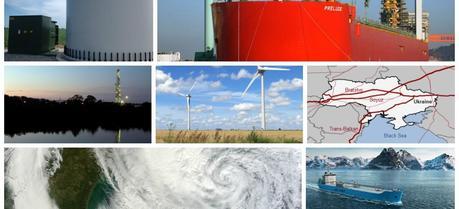
Energy experts react to the Kremlin’s annexation of Crimea; the EU seeks to reduce its dependence on Russian natural gas imports; two studies show that wind energy can become, or already is, a viable alternative to fossil fuels; new technologies switch the focus away from conventional onshore natural gas production. We have collected all these stories and more of the most important energy news of the past month conveniently in one place for you to read.
Energy Experts React to Russia’s Annexation of Crimea
Europe, including all EU members plus Turkey, Norway, Switzerland, and the non-EU Balkan states, consumed 18.7 trillion cubic feet (Tcf) of natural gas in 2013. Russia supplied 30% (5.7 Tcf) of this volume, with a significant amount flowing through Ukraine. According to the estimations by the EIA, 16% (3.0 Tcf) of the total natural gas consumed in Europe passed through Ukraine’s pipeline network, based on data reported by Gazprom and Eastern Bloc Energy.
Natural gas exports to Europe through Ukraine vary by season, ranging from almost 12 billion cubic feet (Bcf) of natural gas per day in the winter to only 6 Bcf per day in the summer. An unusually mild winter in 2013 meant reduced natural gas flows through Ukraine and contributed to higher levels of natural gas storage in Europe (natural gas storage levels were 46% full as of March 13, compared to 23% full in the United States).
Yet, according to the European Wind Energy Association’s chief executive Thomas Becker, a 30% renewables target for 2030 would cut Europe’s dependence on natural gas imports (including from Russia) by 26%. After a letter to Europe’s leaders last month, Becker said: “The situation in the Crimea is a wake-up call: Europeans rely on the most unstable and volatile parts of the world for energy security. For each new fossil fuel fired plant we build, we commit to buying the fuel abroad for years to come without security.”
“Each European is sending €2 net per day to sources outside of the EU,” he added, “Let us stop creating wealth for the already wealthy in Russia, Qatar and Saudi Arabia. Instead let us invest in wind and renewables—European energy sources which do not have to be imported, which will not run out,” he added.
Still, according to new research from mathematicians at Queen Mary University of London, a decentralized approach to managing congestion on gas pipeline networks could be crucial for energy security during geopolitical conflicts or natural disasters. “Natural gas accounts for 24 per cent of energy consumption in Europe,” said co-author Professor David Arrowsmith from Queen Mary’s School of Mathematical Sciences. Nations are now undergoing unprecedented change in the nature of energy resources and in their increased interdependency on each other for the security of supply.”
Co-author Rui Carvalho, Research Fellow at Queen Mary’s School of Mathematical Sciences, commented: “Our decentralized control algorithm, which is inspired by mathematical models of internet traffic, manages any disruption automatically, by minimizing network congestion in a way that is fair to all parties involved. However, to mitigate the effect of crises, nations must ultimately cooperate by sharing access to their energy networks.”
Richard Branson, an English business magnate and investor best known as the founder of Virgin Group, said in a recent blog post that the U.S. and EU must treat the situation in Crimea with a real sense of urgency, as Russia continues to intervene in Ukraine.
“As well as politicians, business leaders also need to stand up for Ukraine. One important area to focus upon is clean energy. We should all be converting more quickly to clean fuels. As the political reaction in Crimea has shown, we rely too heavily on Russia for energy supplies. Being in a position where every country is able to operate at 100% capacity, while not relying on Moscow for energy supplies, would be beneficial — especially if this change enabled us to put a greater emphasis on clean energy. We need to ensure that future European generations will be able to get clean energy supplies from the US and elsewhere without being in danger of being held to ransom by Russia,” said Richard Branson.
Wind Energy
While many in Europe are looking to reduce the dependence on Russian natural gas, two studies have emerged that suggest that wind energy, at least potentially, can become a viable alternative to fossil fuels.
According to a new Stanford study, today’s wind industry, even with the necessary batteries and other grid-scale storage, is energetically sustainable.
“Whenever you build a new technology, you have to invest a large amount of energy up front,” said Michael Dale, a research associate at Stanford. “Studies show that wind turbines and solar photovoltaic installations now produce more energy than they consume. The question is, how much additional grid-scale storage can the wind and solar industries afford and still remain net energy providers to the electrical grid?”
The researchers found that from an energetic perspective, the wind industry can easily afford lots of storage, enough to provide more than three days of uninterrupted power. However, the study also revealed that the solar industry can afford only about 24 hours of energy storage. That’s because it takes more energy to manufacture solar panels than wind turbines.
“Wind technologies generate far more energy than they consume,” Dale said. “Our study showed that wind actually produces enough surplus electricity to support up to 72 hours of either battery or geologic storage. This suggests that the industry could deploy enough storage to cope with three-day lulls in wind, common to many weather systems, and still provide net electricity to society.”
The most popular posts in March, 2014
1. New Technology Enables People to ‘See’ Radiation
2. Wind Industry, Even With Energy Storage Costs, Is Sustainable
3. Small Modular Reactors Could Provide Safer Nuclear Energy
4. Scientists Use Infrared Emissions as Renewable Energy Source
5. Flexible Blade to Reduce Wind Energy Costs
The results were especially good for onshore wind turbines. “We found that onshore wind backed by three days of geologic storage can support annual growth rates of 100 percent—in other words, double in size each year—and still maintain an energy surplus,” he said.
Another study goes even further and says that the costs of using wind energy and natural gas for electricity are virtually equal when accounting for the full private and social costs of each, making wind a competitive energy source for the United States.
Just released by researchers at Syracuse University and the University of California, the analysis shows that wind energy comes within .35 cents per kW·h when levelized over the 20-year life of a typical wind contract, compared on an equivalent basis to the full costs for natural gas-fired energy, according to Jason Dedrick, associate professor at the School of Information Studies (iSchool).
“The true costs of electricity from wind power and natural gas are effectively indistinguishable, yet because the cost of carbon emissions is not included in the market price of gas, wind has not been a competitive form of energy use in most of the United States, without government pricing support,” Dedrick says.
Another possible, if far-fetched, advantage of wind power is that it might weaken hurricanes. At least, that is according to a new research by the University of Delaware and Stanford University. The findings of the study demonstrate for the first time that offshore wind turbines can buffer damage to coastal cities during hurricanes.
Using their sophisticated climate-weather model, the researchers simulated hurricanes Katrina, Isaac and Sandy to examine what would happen if large wind farms, with tens of thousands of turbines, had been in the storms’ paths.
They found that, as the hurricane approached, the wind farm would remove energy from the storm’s edge and slow down the fast-moving winds. The lower wind speeds at the hurricane’s perimeter would gradually trickle inwards toward the eye of the storm.
“There is a feedback into the hurricane that is really fascinating to examine,” said Archer, an expert in both meteorology and engineering.
The highest reductions in wind speed were by up to 87 miles per hour (mph) for Hurricane Sandy and 92 mph for Hurricane Katrina.
According to the computer model, the reduced winds would in turn lower the height of ocean waves, reducing the winds that push water toward the coast as storm surge. The wind farm decreased storm surge—a key cause of hurricane flooding—by up to 34 percent for Hurricane Sandy and 79 percent for Hurricane Katrina.
While the wind farms would not completely dissipate a hurricane, the milder winds would also prevent the turbines from being damaged. Turbines are designed to keep spinning up to a certain wind speed, above which the blades lock and feather into a protective position. The study showed that wind farms would slow wind speeds so that they would not reach that threshold.
Interestingly, a year ago we reported on a study that said that medium-sized waves can break offshore wind turbines like matches.
Natural Gas
At the same time, new technologies related to natural gas switch the focus away from conventional onshore natural gas production.
According to the EIA, the productivity of oil and natural gas wells is steadily increasing in many basins across the United States because of the increasing precision and efficiency of horizontal drilling and hydraulic fracturing in oil and natural gas extraction. The geology of each oil and natural gas resource play is diverse, and individual rig or well performance can vary dramatically. However, drilling activity in U.S. shale plays is now generally producing greater quantities of oil and/or natural gas than in the past. This trend of increasing rig productivity is one factor helping to increase the nation’s oil and natural gas production. The latest Annual Energy Outlook forecasts that U.S. oil production will reach 9.6 million barrels per day in 2019, and natural gas production will increase by 56% through 2040.
According to a review by the British Geological Survey, there is, however, a need for strict regulatory controls over wells drilled onshore in the future (including those for shale gas).
Dr Rob Ward, Director of Groundwater Science at the BGS said, “This extensive review of published information shows that hydrocarbon well integrity problems are a real issue. Despite this, there has been only one reported incidence of a UK onshore operational hydrocarbon well causing pollution due to well integrity failure, although there is a lack of of information for the many hundreds of other abandoned wells. Analysis carried out by the BGS, as part of the study, shows that 45 per cent of the 2152 hydrocarbon wells drilled since 1902 penetrate highly or moderately productive aquifers. These aquifers are important for drinking water supply and supporting flow in rivers and wetlands, and so any leakage from the wells could have significant environmental impact and require costly remediation.”
Meanwhile, Shell floated out the hull for the world’s largest floating liquefied natural gas (FLNG) facility. The 488-meter-long (1601 ft.) hull of Shell’s Prelude FLNG was floated out of the dry dock at the Samsung Heavy Industries (SHI) yard in Geoje, South Korea, where the facility is currently under construction. Once complete, Prelude FLNG will be the largest floating facility ever built. It will unlock new energy resources offshore and produce approximately 3.6 million tonnes of liquefied natural gas (LNG) per year to meet growing demand.
FLNG will allow Shell to produce natural gas at sea, turn it into liquefied natural gas and then transfer it directly to the ships that will transport it to customers. It will enable the development of gas resources ranging from clusters of smaller more remote fields to potentially larger fields via multiple facilities where, for a range of reasons, an onshore development is not viable. This can mean faster, cheaper, more flexible development and deployment strategies for resources that were previously uneconomic, or constrained by technical or other risks.
And a new fully mobile buoyant transfer system for offloading natural gas from ships to land may lead to increased LNG distribution to new markets around the world.
“Currently, a port requires specially constructed facilities for offloading LNG from carriers,” explains Morten A. Christophersen, Managing Director of Connect LNG. “We are developing an alternative solution for transferring the gas from ships to onshore bunkers that makes it possible to utilize simpler LNG terminals. This would help to increase distribution and use of natural gas, in more sparsely populated corners of the world as well.”
“The core of our system is a buoy loading system that is used to connect a flexible transfer line between ship and land,” says Mr Christophersen. “The LNG is transferred through this line.”
The company calls its solution the Universal Buoyancy System. It will help to cut costs and construction time, with the added advantage that it can be moved to wherever in the world there is demand for natural gas. In combination with conventional pressurized tanks, the buoyant transfer system is virtually 100 per cent mobile and is easy to set up. Different types of ships will be able to use the system with no need for redesign.
This month in photos: March 2014
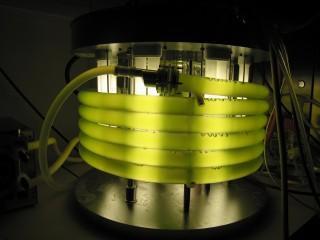
Growing algae at VTT’s laboratory. (Credit: VTT Technical Research Centre of Finland)

Jae Yong Lee, Electrical Engineering PhD Student, tests a colored solar cell. (Credit: Joseph Xu / Michigan Engineering Communications & Marketing)
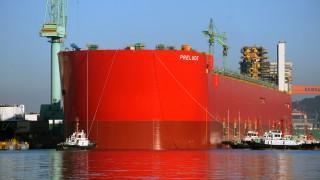
Shell’s Prelude FLNG will be the largest floating facility ever built. (Credit: Royal Dutch Shell plc)
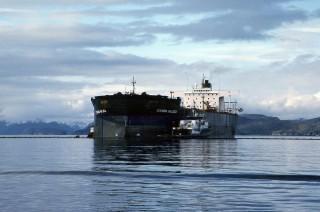
Exxon Valdez. (Credit: NOAA Office of Response and Restoration)
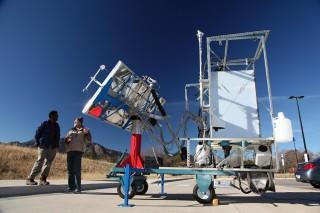
CU-Boulder postdoctoral researcher Tesfayohanes Yakob, left, and research engineer Dana Haushulz are shown here with a novel solar-thermal toilet developed by a team led by CU-Boulder Professor Karl Linden as part of the Bill & Melinda Gates Foundation’s “Reinvent the Toilet Challenge” to improve sanitation and hygiene in developing countries. (Credit: University of Colorado)

Sandia National Laboratories researcher Matt Lave uses pyranometers like these to measure the amount of irradiance, or available sunlight. There are four round pyranometers, capped by small glass domes, on this device. The work shows that the variability of a point sensor is larger than the variability of a photovoltaic power plant. (Credit: Dino Vournas / Sandia National Laboratories)

